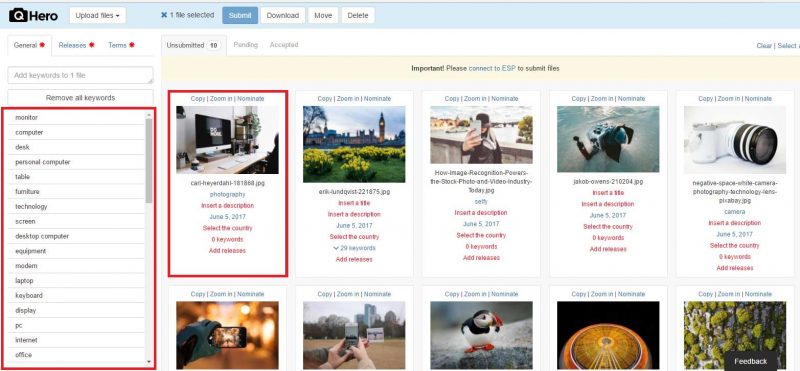Stock photography and videography have become popular work options for many visual professionals seeking freedom and creative expression. At the same time, royalty-free images and videos are constantly needed across industries: from advertising agencies to the marketing departments of a wide range of businesses across the globe.
Besides creating the visual assets, stock contributors often need to take care of the technical details such as uploading, organizing and tagging with keywords the images and videos. Since success in the industry often means developing huge visual databases, this process can get time-consuming and tedious.
Forward-looking stock websites have started embedding image recognition AI in their platforms to address the need for faster and more efficient keyword tagging. Tools like Qhero use image recognition to offer intelligent keywording to stock contributors of major stock websites like iStock. Using Qhero is very easy, simply upload your photos and they choose for which one you want to receive AI generated tags based on image recognition. Then you can choose the keywords that match the description of the image or simply validate them all.

How accurate are Artificial Intelligence suggested keywords?
Until recently, it was seen that image recognition cannot offer the high level of precision in keyword tagging that is expected. This led to the gradual adoption of computer vision for stock photo and video tagging. Today, the power that AI image tagging offers has changed this perception in the field. More and more stock photography and videography platforms are embedding AI to facilitate the process of keyword metadata enhancement. Here’s how the advancements in image recognition are fueling the progress in the stock photo industry.
Keyword suggestions for stock contributors
One of the main uses of image recognition AI is to help stock photo and video contributors describe their content with automatic keyword suggestions. Artificial Intelligence identifies the main objects, backgrounds, and themes in a visual. Then it generates a set of keywords with very high accuracy.
The approach to keyword tagging adopted by stock websites is mostly semi-automated. Image recognition technologies like Imagga suggest relevant keywords. The contributor has to manually approve them so that they are attributed to the visual.
Keyword suggestion powered by image recognition AI can save enormous amounts of time for stock contributors uploading royalty-free photos, vector graphics, and videos. They often upload large volumes of visuals, which need to be properly tagged with keywords, so that they are discovered by buyers. It usually takes time for contributors to get a hold of good keyword tagging that will bring them sales. They also need to predict buying trends and adjust keyword tagging accordingly. By automating with an advanced technology like computer vision, this process can be facilitated and improved.
Additionally, stock photography and videography websites have specific requirements on the number, quality, and theme of the tags. Contributors have to comply with these rules in order for a visual to go through the website’s approval process. This can mean hundreds of hours of manual tagging, which makes automated keyword suggestions so precious for contributors.
Besides saving a ton of time, keyword suggestions can save contributors money as well. Some professional stock photographers are paying specialized agencies to manually tag their images with relevant keywords. With image recognition providing automatic keyword suggestions, they have a viable option to switch back to handling the tagging on their own.
The AI-powered keywording functionality for QHero created by Imagga is a good illustration of how image recognition can speed up tagging of visuals. With the help of our API, intelligent keyword suggestions are now offered in the QHero image uploader software to assist stock contributors with their keyword tagging.
Robust search options for stock users
Keywords are important metadata not only for search engines but also for the stock photo and video websites. Adequate keyword tagging helps platforms categorize their visual content and make it discoverable for buyers. By providing AI-powered search options, image recognition can make discovering images faster and more efficient.
Image recognition can enhance visuals’ indexing for stock websites, so content can become more easily discoverable. Stock contributors get automatic keyword suggestions that complement their manual keyword tagging. The keyword attribution process is thus enriched and can be more widely encompassing, as a greater amount of relevant keywords can be attributed to the stock visuals.
Improved discoverability of stock visual content brings immense benefits for all parties involved. Stock photo users can find the visuals they need seamlessly. This makes their experience with stock platforms better. This, in turn, can help boost stock photo sales.
Content that was underperforming because of poor keyword tagging gets better exposure. Newly uploaded visuals automatically get more advanced tagging. This translates into direct financial benefits for both contributors and stock platforms, which earn a percentage of every sale.

You can see a good example of how image recognition was integrated into a popular free stock photo platform in Imagga’s Unsplash case study. Unsplash is a website that offers royalty-free images for free download. Photo contributors may not always have the time to add enough keywords to their images, as they don’t get direct payment. With Imagga’s technology, this process was automated.
Our computer vision API allowed Unsplash to offer advanced search options for its users. Besides traditional search of photos by keyword, all photos are discoverable by categories such as nature, people, and the like. Today more than five million searches are conducted with an Imagga-powered Unsplash search capability.
The creative market today can greatly benefit from AI-powered keyword tagging. Stock photographers and videographers can save time and money in the tedious process of attributing keywords to their visual assets. In the same time, stock buyers can get improved search options and easier content discovery.
What are the benefits of image recognition in your project? We’d love to get your insights in the comments below!
